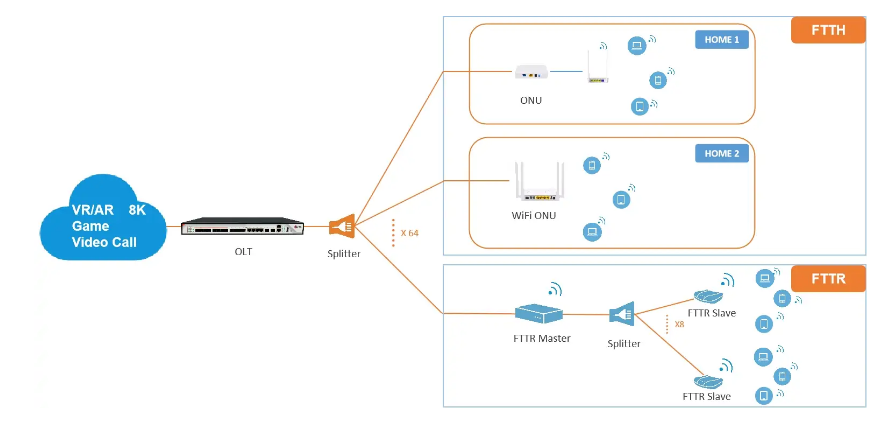01.What is FTTR?
The optical access network is the first entry point for "connection + computing power + capability". Operators are comprehensively improving the bandwidth, latency and coverage of the optical access network and other basic network capabilities to achieve a 10G experience guarantee for users. The optical + Wi-Fi collaborative networking is based on the FTTR (Fiber to The Room) main equipment as the control center, and the optical + WLAN joint scheduling is used to achieve orderly transmission and reception of Wi-Fi networking within the domain; with OLT as the control center, cross-domain seamless roaming for FTTR dense deployment scenarios is achieved.
FTTR (Fiber to The Room), that is, fiber to the room, as an advanced version of FTTB (Fiber to the Building) and FTTH (Fiber to the Home), has become an ideal choice for achieving gigabit network coverage throughout the house with its excellent performance and flexibility. FTTR not only lays optical fiber to every room, but also combines advanced dual-band Wi-Fi technology to ensure full coverage and seamless switching of the home network, bringing users an unprecedented network experience.


02. Product features and future development
The core of FTTR products lies in its flexibility and scalability . With the main optical modem as the core of the network, based on the splitter and single-core bidirectional optical fiber, FTTR can connect to the slave optical modems in each room in a P2MP manner. Build an efficient and stable home fiber optic network. In more popular terms, your home used to have "one optical modem", and the implementation of FTTR will give you "a group of optical modems".
From the existing product configuration, FTTR already has a variety of mainstream configurations, such as the upstream XGPON optical port with different numbers of Gigabit LAN ports and GPON mini-OLT optical ports.
(1) Upstream XGPON optical port, downstream 4 Gigabit LAN ports, downstream GPON mini-OLT optical port;
(2) Upstream XGPON optical port, downstream 2 Gigabit LAN ports; downstream GPON mini-OLT optical port;
(3) Upstream XGPON optical port, downstream 3 Gigabit LAN ports + 1 2.5G LAN port, downstream GPON mini-OLT optical port.
In the future, with the continuous advancement of technology, FTTR is expected to evolve into a configuration with more 2.5G LAN ports and even symmetrical 2.5GPON mini-OLT optical ports in the downstream , further improving network speed and stability. In the production process of FTTR products, how to ensure production quality, test efficiency, and environmental compatibility has become an important challenge faced by manufacturers and test equipment suppliers. Especially in the context of rapid product iteration and update, how to ensure that test equipment can flexibly support the testing needs of new products has put forward higher requirements for test solutions.